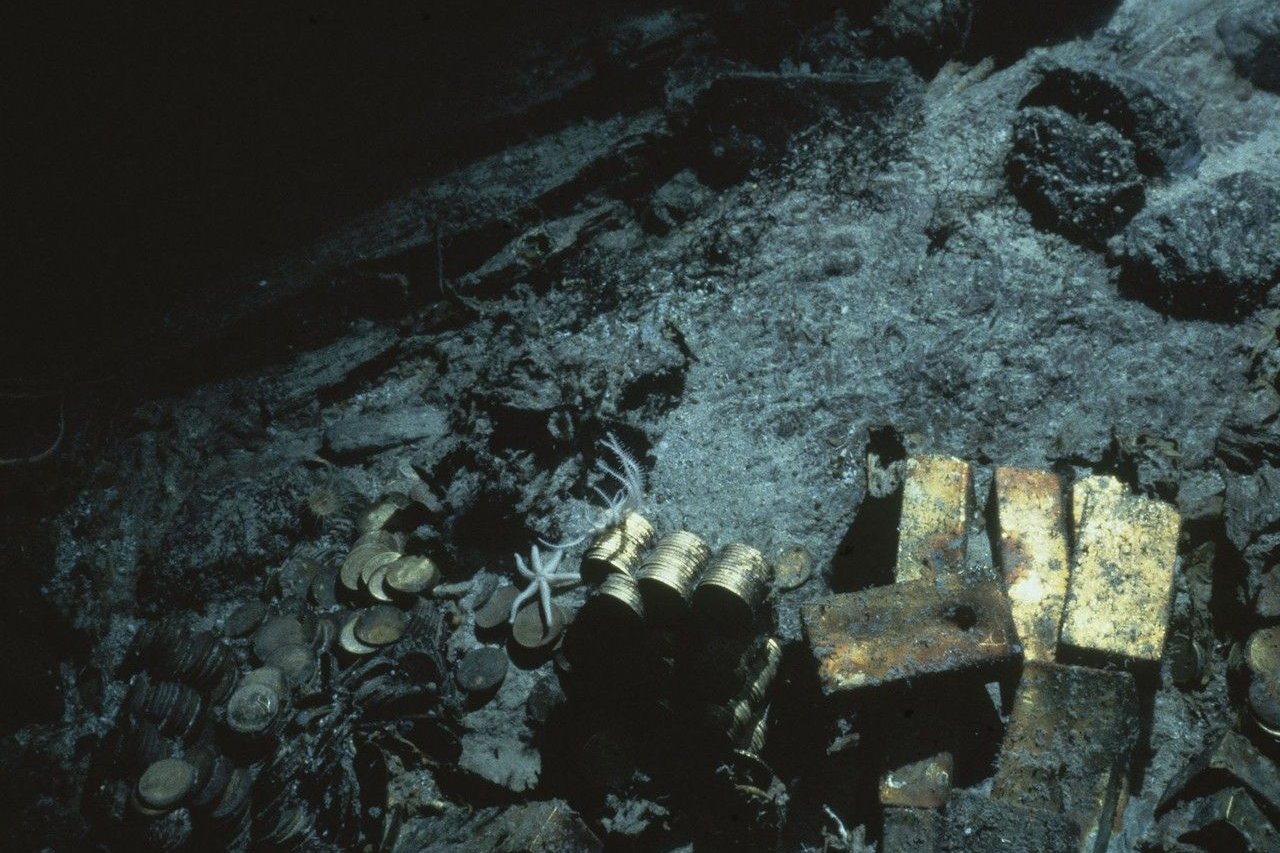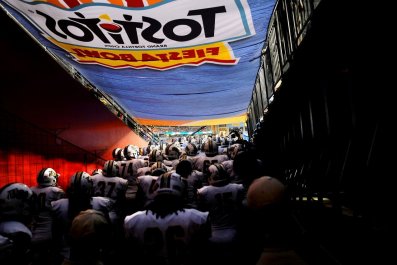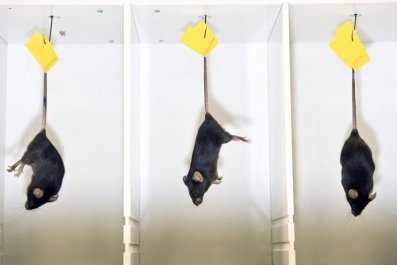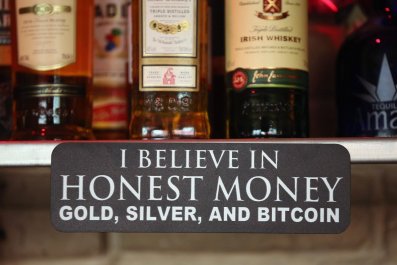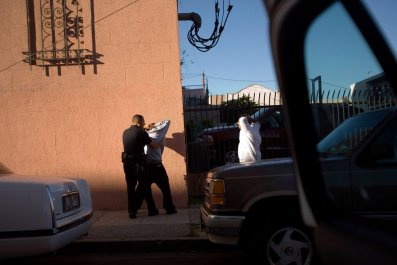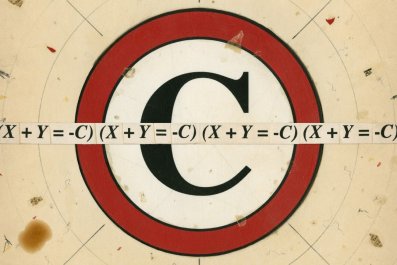Mike Milosh stared into the monitor showing video from a shipwreck two miles below him. His remotely operated vehicle, Nemo, had stirred up a cloud of sediment, and he was eagerly waiting for it to settle. When it did, he remembers, a pile of 50 gold bars appeared on the screen.
"There was a lot of high-fiving," says Milosh, a lead engineer for the 1989 mission to recover the cargo of treasure from the sunken S.S. Central America.
More than $40 million in gold was recovered from the wooden-hulled, copper-sheathed, sidewheel steamship that sank off the Carolina coast in 1857, at the height of the Gold Rush. Next month, the S.S. Central America will receive its first visitors in more than two decades, when a group of shipwreck experts go down to try to recover any remaining treasure. Some estimates put the potential prize at close to $100 million.
But rather than a triumphant story of adventure and riches, the S.S. Central America, considered by many the Titanic of the 19th century, has become a cautionary tale of ambition, costly legal battles, embittered friendships and repentant investors. Its lead discoverer is now a fugitive.
The Thrashing Atlantic
As the S.S. Central America pulled out of Panama for what would become its final voyage, its hold and the pockets of many of its roughly 580 passengers brimmed with gold ingots and freshly minted coins, recently gathered from California mines swarming with fortune seekers.
Shortly after a layover in Havana, the vessel sailed into the heart of a hurricane. The ship sprung a leak, moistening the coal and grinding the engines to a halt. Shortly before it sank, a small vessel came into view and was able to take the women and children of the S.S. Central America onboard. The men, and the gold, soon plunged to the bottom of the thrashing Atlantic.
At the time, New York banks were awaiting the gold shipment, and the ship's sinking, historians say, contributed to the Panic of 1857, which led to a brief but severe economic depression in the United States.
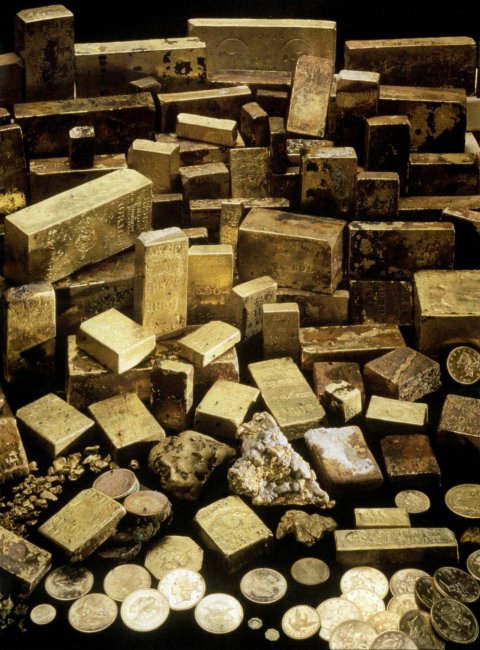
Finders, Weepers?
For more than a century, the ship lay on the seabed, 7,200 feet below the surface, attracting starfish and the occasional visit from a curious Greenland shark. Just how much gold it holds has been a mystery as well. The official tally of cargo was three tons. Passengers were said to be carrying as much again on their person, and there may also have been a secret army shipment of even more gold, according Gary Kinder, author of a book about the sinking, Ship of Gold in the Deep Blue Sea. The total may have been as high as 21 tons of gold.
It took an all-encompassing passion for shipwrecks, cutting-edge technology, boundless patience and millions of dollars to find the ship. Thomas G. Thompson had all but the last. A bespectacled research scientist from Defiance, Ohio, he spent much of the 1980s creating the necessary machinery to explore the deep ocean while working at Battelle Memorial Institute, a research and development company. During that time, he started mapping the seafloor in the area and wooing investors to finance the search and recovery. Wealthy Ohioans, including the Dispatch Printing Co., which owns The Columbus Dispatch, poured more than $10 million into Thompson's mission.
The wreck's location, approximately 160 miles off of South Carolina, was discovered in 1987. Shortly after, Nemo began bringing up ingots and coins, and along with them, a time capsule from the previous century. Daguerreotype photos, dueling pistols and rare marine species—including, coincidentally, gold coral—were discovered in the wreck.
Thompson became a celebrity. "As things moved ahead and Tom got a lot of kudos for being a good entrepreneur, things changed," says Milosh. "His personality changed, became a lot more reclusive."
The euphoria was short-lived. The first batch of gold had just come ashore when a group of American and British companies that had insured the steamship's cargo 135 years earlier claimed rights to the treasure and filed suit. In 1990, the Federal District Court in Norfolk, Va., ruled that the salvagers, Thompson and his company, Columbus-America Discovery Group, were the owners of the treasure, according to the principle of finders keepers.
The insurance companies appealed. In 1992, a federal appeals court reversed the trial court's decision, ruling that Columbus-America had not shown that the insurers abandoned the treasure. A second trial was held in 1993, in which the court held that Columbus-America was entitled to 100 percent of the uninsured gold and 90 percent of the insured gold. Columbus-America and the insurers agreed to split the treasure, with the former receiving approximately 92.5 percent of the recovered treasure.
In the meantime, Thompson had been accruing debt to continue financing his exploration project. When he sold the gold he had pulled up from the S.S. Central America in 2000 to California Gold Marketing Group, none of the profit made it to investors' pockets. "One hundred percent of every dime that came in from the sale of the treasure to California Gold was used to settle the lawsuits," says Gilman Kirk, an investor and a close friend of Thompson's.
Whereabouts Unknown
Investors sued Thompson in 2005, and the case is ongoing. In 2012, after he failed to show up for a hearing related to the case, a federal judge issued an arrest warrant. Avonte Campinha-Bacote, an attorney who used to represent Thompson, said he withdrew as Thompson's counsel in November after not hearing from his client, and he was not aware of any other lawyer representing him.
According to The Columbus Dispatch, Thompson had been living in a rented mansion in Vero Beach, Fla., before he fled. His current whereabouts are unknown.
"I had a lot of respect for Tommy Thompson, and I believed he was a straight shooter and was really motivated by the scientific challenges as much as the potential for wealth," says Mike Williamson, a plaintiff in one of the lawsuits against Thompson. "He seems to have somewhere along the line changed his ethics and outlook on the world."
Even those who came to know Thompson well are puzzled by the outcome of his mission. "There are four things I know for sure," says Kinder. "I know that they were successful in finding the gold. I know that the gold was worth a lot of money. I know that the investors never got paid anything. And I know that Tommy is honest. But those things don't work, they don't go together."
Still, Thompson retains a group of staunch defenders. "What they've done to him is criminal. They've run him out of town. They call him a crook. He's not. He's a scientist," says Donald Garlikov, an investor who has remained loyal to Thompson despite admitting that he's never received any percentage of the treasure's profit.
Earlier this month, Odyssey Marine Exploration, a publicly traded, Florida-based company that specializes in deep-ocean shipwreck exploration, announced that it had been awarded an exclusive contract to recover the remaining gold from the S.S. Central America.
Odyssey, which was chosen by a court-appointed receiver representing the companies that Thompson created to finance the S.S. Central America project, says it plans to begin exploring the wreck site next month. Odyssey will receive 80 percent of recovery proceeds up to a fixed fee and 45 percent thereafter.
The wealth to be had could be substantial. A gold coin that was recovered was sold for $11,750 by Heritage Auctions last year. The Eureka bar, at approximately 80 pounds and believed to be the "largest and heaviest gold numismatic item known to exist," according to Monaco Rare Coins, was sold for $8 million in 2001.
Experts hired by the court-appointed receiver estimate that the ship still holds anywhere from $343,000 to $1.4 million of gold, in 1857 value. According to some estimates, that could be as much as $97 million on today's prices.
For some, the upcoming exploration is as much about the potential wealth as it is about completing a personal, lifelong mission. Bob Evans, the chief scientist of the initial mission says he is thrilled to go back to the S.S. Central America after 23 years. "We are going to explore much more of the shipwreck this time, with much more modern equipment, he said. "We expect new, wonderful things to show up."
Correction: An earlier version of this story mistakenly said the experts who estimated the value of the gold were hired by Odyssey Marine. They were hired by the court-appointed receiver representing the companies that Thompson created to finance the S.S. Central America project.



